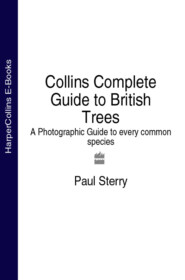скачать книгу бесплатно
Hawthorn flowers are an attractive sight in spring and are irresistible to pollinating insects.
HAZEL – NUTS
CRAB APPLE – FLESHY FRUIT
SYCAMORE – WINGED SEEDS
GUELDER-ROSE – BERRIES
The fruits of broadleaved trees and shrubs come in a range of shapes and size, including winged seeds, hard-cased nuts, luscious berries and juicy fruits.
WHAT IS A TREE? (#ulink_8a944caf-1030-5678-bef8-0b1ecd3d6e36)
Nobody could have any doubt that a mature Wellingtonia or an ancient, spreading Pedunculate Oak is a tree, but would a prostrate Juniper, or a Creeping Willow, also qualify, or are they merely shrubs? One feature common to both trees and shrubs is that their stems increase in thickness each year by the laying down of internal layers of woody tissue in the form of concentric rings. This secondary thickening builds up year by year to increase the diameter of the stem and gives a permanent record of the age of the tree or shrub.
Trees are generally considered to have a single main stem of 5m or more in height with a branching crown above this, whereas shrubs may have numerous stems arising at ground level and may not normally reach the height of a tree. Both trees and sizeable shrubs are covered in this book but the distinction is not always clear. Individuals of the same species may become trees or form shrubs, depending on the circumstances in which they are growing, or their management. Hazel, for example, forms a multi-stemmed shrub in response to coppicing, or cutting back to the rootstock; each time this is done, new shoots arise from the rootstock and the Hazel regenerates. If this cutting back does not take place, it can grow as a medium-sized tree on a single stem.
Trees do not belong to a single family of plants; many plant families are represented, and some, like the Fabaceae and Rosaceae, also include many herbaceous plants and shrubs as well as large trees.
The plant kingdom is divided into two main classes, the Gymnosperms and the Angiosperms. The most primitive of the two classes is the Gymnosperms, the name meaning ‘naked seeds’; the ovule is borne on a bract and not enclosed in a seedpod or case. This class includes the Maidenhair Tree, a very primitive tree, and all the conifers, or cone-bearing trees.
The name Angiosperm means ‘hidden seeds’ and refers to the way the seeds are contained inside an ovary, a structure that may later develop into a seedpod or fruit. This large class includes many well-known plant families, some of which are mostly made up of herbaceous plants, and some of which are mostly composed of trees. The Limes (Tiliaceae) and Elms (Ulmaceae), for example, are mostly trees, whilst trees feature in only one of many genera in the Foxglove family (Scrophulariaceae). All of our garden and wild flowers, bulbs, palms and the grasses and cereals are Angiosperms.
With their massive trunks, there is no mistaking that these Common Beeches are indeed trees.
Вы ознакомились с фрагментом книги.
Для бесплатного чтения открыта только часть текста.
Приобретайте полный текст книги у нашего партнера:
